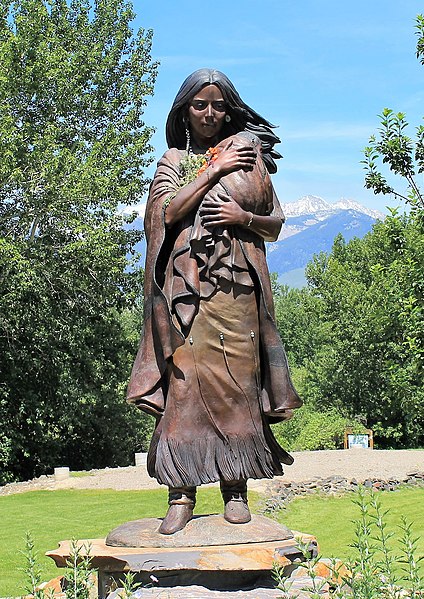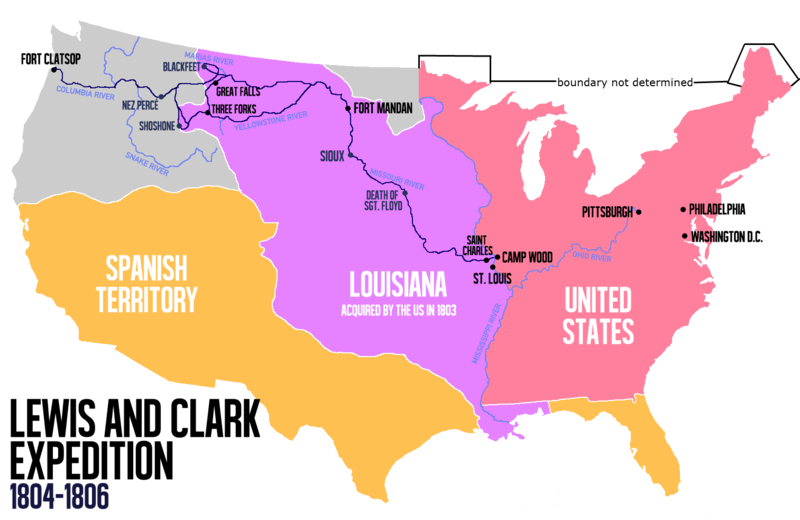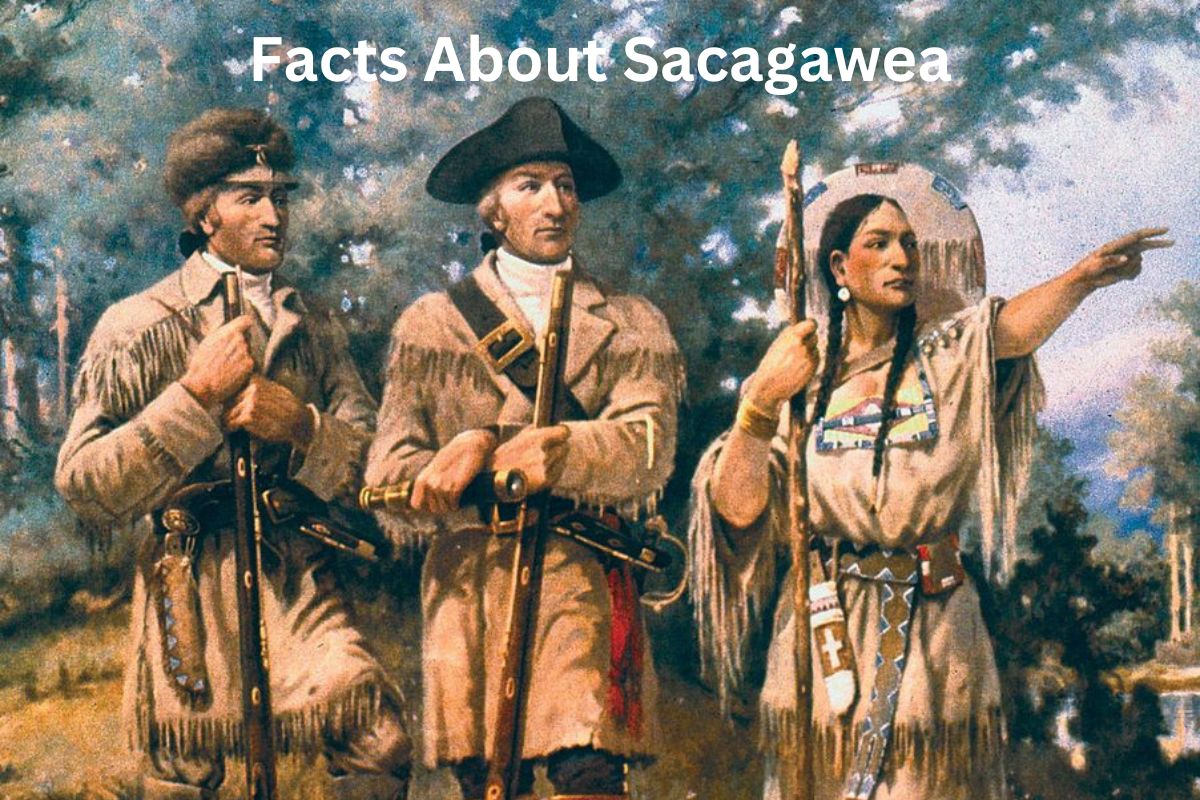Sacagawea, a Shoshone woman born in 1788, holds a significant place in American history for her role as an interpreter, guide, and symbol of resilience and cultural diversity.
She is best known for her involvement in the Lewis and Clark Expedition, a pioneering journey that explored the uncharted western territories of the United States in the early 19th century.
Sacagawea’s contributions to the expedition were instrumental in establishing diplomatic relations with Native American tribes, negotiating for essential resources like horses, and providing invaluable knowledge of the land and its resources.
Her presence on the expedition, carrying her infant son Jean Baptiste Charbonneau, symbolized the strength and endurance of women in the face of adversity.
Sacagawea’s story and legacy have captured the imagination of generations, and she continues to be celebrated as a trailblazer and an icon of Native American history and cultural heritage.
Sacagawea Facts
1. Sacagawea is best known for her role as an interpreter and guide for the Lewis and Clark Expedition
Sacagawea was a Shoshone woman who is best known for her role as an interpreter and guide for the Lewis and Clark Expedition in the early 19th century.
The Lewis and Clark Expedition, also known as the Corps of Discovery, was commissioned by President Thomas Jefferson to explore and map the newly acquired western territory of the United States after the Louisiana Purchase in 1803.

2. She was born in 1788 in what is now Idaho, USA, and her birth name was “Sakakawea”
Sacagawea was born in 1788 in what is now Idaho, USA. Her birth name was “Sakakawea,” which means “bird woman” in the Hidatsa language. She belonged to the Lemhi Shoshone tribe and spent her early years in the Rocky Mountains region.
3. In 1800, when she was around 12 years old, Sacagawea was captured by a Hidatsa raiding party
In 1800, when Sacagawea was around 12 years old, she was captured by a Hidatsa raiding party during a battle with the Shoshone.
She was taken to their village in present-day North Dakota, where she was later sold to a French-Canadian fur trader named Toussaint Charbonneau. Charbonneau would become her husband.
4. Sacagawea joined the Lewis and Clark Expedition in 1804 when she was pregnant with her first child
Sacagawea joined the Lewis and Clark Expedition in 1804 when she was pregnant with her first child. Her presence was valuable to the expedition because she could speak both the Shoshone language and the Hidatsa language.
This linguistic ability enabled her to communicate with different Native American tribes the expedition encountered during their journey.

5. On February 11, 1805, Sacagawea gave birth to a son named Jean Baptiste Charbonneau
On February 11, 1805, Sacagawea gave birth to a son named Jean Baptiste Charbonneau. He became the youngest member of the expedition, and his presence often helped to ease tensions with Native American tribes they encountered along the way.
Lewis and Clark grew fond of Jean Baptiste and referred to him as “Pompy,” a nickname given to him by Sacagawea. The baby was often carried on Sacagawea’s back during the expedition.
6. Sacagawea played a crucial role in the expedition by serving as a guide, translator, and diplomat
Sacagawea played a crucial role in the success of the Lewis and Clark Expedition by serving as a guide, translator, and diplomat. Her knowledge of the Shoshone language became particularly valuable when the expedition reached the Rocky Mountains.
Unbeknownst to Lewis and Clark, Sacagawea’s brother, Cameahwait, was the chief of the Shoshone tribe. With her assistance, the expedition was able to establish contact with the Shoshone people and negotiate for horses, which were essential for crossing the rugged terrain.
7. Sacagawea’s knowledge of edible plants and medicinal herbs was also valuable to the expedition
In addition to her language skills, Sacagawea’s knowledge of edible plants and medicinal herbs proved vital during the expedition. She helped identify and gather various plants that provided sustenance and remedies for illnesses.
Her expertise in finding edible roots, berries, and other food sources helped sustain the expedition when provisions ran low, and her medicinal knowledge helped treat the expedition members’ ailments.
8. Sacagawea and her family traveled thousands of miles with the expedition
Sacagawea, along with her husband and infant son, traveled thousands of miles with the Lewis and Clark Expedition, enduring numerous challenges and dangers along the way.
They faced harsh weather conditions, treacherous terrain, and encounters with wildlife, including grizzly bears. Despite these hardships, Sacagawea remained a resilient and indispensable member of the expedition, contributing to its successful navigation and survival.
9. After reaching the Pacific Ocean in November 1805, the expedition turned back and began its return journey in the spring of 1806
After reaching the Pacific Ocean in November 1805, the Lewis and Clark Expedition began its return journey in the spring of 1806. Sacagawea continued to play a crucial role during the expedition’s homeward travel.
Her knowledge of the terrain and ability to communicate with various tribes facilitated peaceful encounters and ensured the expedition’s safe passage through unfamiliar territories.
10. Sacagawea’s fate after the expedition is uncertain
The exact details of Sacagawea’s post-expedition life are uncertain. Some historical accounts suggest that she died in December 1812 at the age of 24, possibly due to an illness. However, other accounts propose that she lived into her 50s.
According to these accounts, Sacagawea lived on the Wind River Indian Reservation in Wyoming, where she and her husband Toussaint Charbonneau had settled.
Regardless of the exact circumstances, Sacagawea’s contributions to the Lewis and Clark Expedition remain significant, and her story continues to inspire admiration for her courage, resilience, and invaluable assistance to one of the most important exploratory ventures in American history.
11. Sacagawea’s story gained recognition in the early 20th century when her image was chosen for the design of the Sacagawea dollar coin
Sacagawea’s story gained significant recognition in the early 20th century when her image was chosen for the design of the Sacagawea dollar coin.
The United States Mint introduced the Sacagawea dollar coin in the year 2000 as part of an effort to honor and celebrate the contributions of Native Americans to American history. The coin features a depiction of Sacagawea carrying her infant son, Jean Baptiste, on her back.
12. The Sacagawea dollar coin depicts Sacagawea with her infant son, Jean Baptiste, on her back
The Sacagawea dollar coin serves as a lasting tribute to Sacagawea’s important contributions to the Lewis and Clark Expedition. It has become a symbol of her role as a Native American woman who played a significant part in American history and highlights the recognition of her cultural and historical significance.
13. Sacagawea’s role made her a symbol of women’s contributions and the importance of cultural diversity
Sacagawea’s representation on the dollar coin has led to increased awareness and appreciation for her accomplishments among the general public.
Her image has become widely recognized, and the coin has helped to educate people about her role as an interpreter, guide, and cultural ambassador during the expedition.
14. Numerous statues, monuments, and schools have been named in honor of Sacagawea
Sacagawea’s legacy is honored in various ways across the United States. Numerous statues, monuments, and landmarks have been dedicated to her memory.
For example, the Sacagawea statue in Bismarck, North Dakota, depicts her pointing westward, symbolizing her role in leading the expedition. There are also schools named after her, further emphasizing her significance as a historical figure.
15. Sacagawea’s legacy as an explorer, interpreter, and symbol of courage and resilience continues to inspire people today
Sacagawea’s remarkable story continues to inspire people today. Her contributions as an explorer, interpreter, and symbol of courage and resilience highlight the often overlooked role of Native Americans in shaping American history.
Sacagawea’s journey with the Lewis and Clark Expedition serves as a reminder of the importance of cultural diversity, cooperation, and understanding in the exploration and development of the United States. Her story serves as an inspiration for individuals from all backgrounds, emphasizing the potential for individuals to make a significant impact, even in challenging circumstances.
